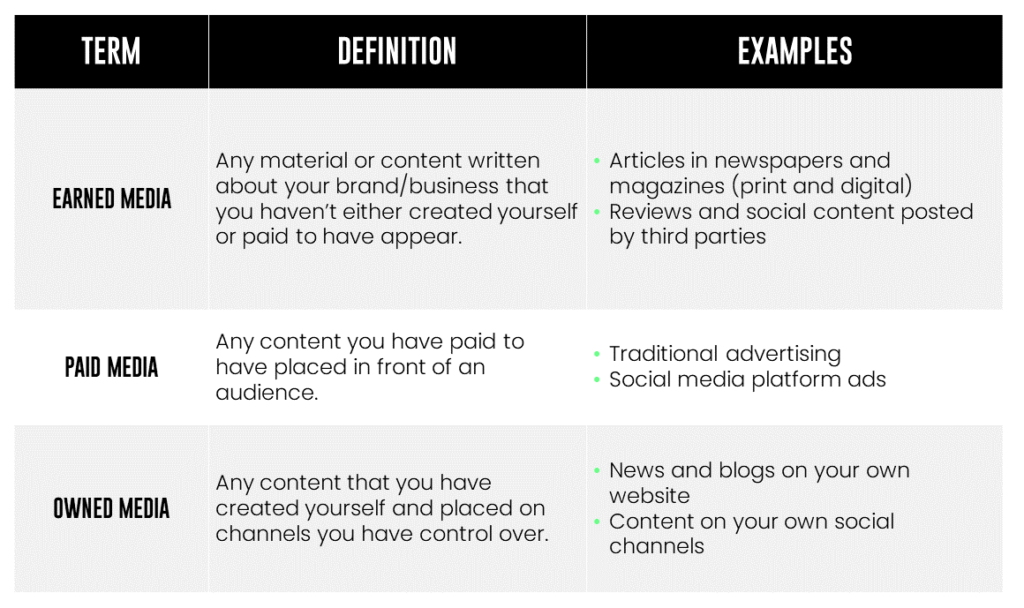What is Earned Media? Earned, Owned and Paid Explained
Like many industries, marketing has its fair share of confusing terminology. As if the plethora of outlets and channels involved in traditional, digital and social media weren’t complicated enough, you’ll also often hear marketers talk about earned, owned and paid media.
So, what is earned media, how does it differ from owned media and paid media, and how do you know which you should be using to market your brand?
DEFINITION OF EARNED MEDIA
Let’s start by defining earned media. It is a term that refers to any coverage or recognition a brand receives from a third-party source it hasn’t paid to create that coverage or recognition. Crucially, it’s not directly controlled by the brand – although a significant percentage of earned media will have been secured through some form of PR or marketing communications activity.
Examples of earned media content could be a news story mentioning a brand in a national newspaper, the inclusion of a particular product in a magazine’s gift guide, or a third-party review on an online review forum.
In contrast, owned media can be defined as any content that a brand has created itself and placed on ‘owned’ channels such as its own website or social media accounts.
Finally, we define paid media as content a brand has paid for, such as an advert or a sponsorship arrangement, where the brand has control over what the content includes and where it is placed.

HOW HAS THE CONTEXT CHANGED?
Before the advent of social media, earned media was all about securing coverage with the right print and broadcast outlets. From journalist reviews, to interviews, feature articles and product round-ups, these routes to audiences are still important for brands.
But the difference now is that the scope of earned media has broadened considerably, to encompass a huge variety of online content from social posts and blogs to online reviews.
Even when solely considering the media relations aspect of earned media, it’s no longer enough for a PR campaign to have a great hook and an interesting angle. A good PR agency now needs to know how to package campaign content in such a way that digital media outlets and their followers will want to share it, in addition to securing the initial coverage.
Other elements falling under the earned media umbrella are even harder to control but do need to be managed effectively. Online review sites, for example, are a highly visible equivalent of more traditional ‘word of mouth’ recommendations. While marketing teams might not be directly responsible for the product quality, operational or customer service functions that result in positive or negative reviews, its best practice to have a marketing-led strategy addressing how to monitor, nurture and respond to that earned content.
WHY IS EARNED MEDIA SO IMPORTANT?
The single most important feature of earned media is its independence. People trust third party endorsement – whether that be from friends and family or a journalist or influencer. Put simply, recommendations that come with an air of impartiality carry more weight.
The added credibility that comes from content being outside the control of the brand, which makes securing it so desirable, is also one of the reasons it is not easy to do well.
Traditionally, earned media was well and truly the preserve of PR. It is so intrinsically linked with reputation and brand awareness, that as the scope of earned media has expanded, the remit of public relations has expanded with it. So, if you’re working with a PR agency today that is only talking about traditional media relations, then you’re missing opportunities to secure earned media content across multiple digital and social channels.
While no form of earned media comes with any guarantees, experienced PR people know how to craft compelling stories and build the media relationships that increase the likelihood of landing that all important coverage.
The ability of earned media to build community and conversation around a brand is what makes it such a valuable part of a wider marketing strategy. Devising a strategy that blends earned, owned and paid media – allowing each strand to play to its strengths and ensuring all activity relates back to core brand goals and messaging – will deliver the most effective results.
The author: Jane Ainsworth is managing director of WPR. She has more than 25 years’ experience in developing and delivering communications strategies and impactful consumer PR for brands including Dunelm, Tesco, Warner Leisure Hotels, Greene King, Alton Towers, Beaverbrooks and Oxfam.

WPR is an award-winning PR agency, based in Birmingham, renowned for getting the world talking about the brilliant brands we work with. We specialise in consumer PR, across sectors including food and drink, retail and leisure; B2B PR, where we work with companies spanning manufacturing, construction and HVAC industries; and social media.
To start a conversation about how we can get the world talking about your business, please get in touch – we’d love to chat.
